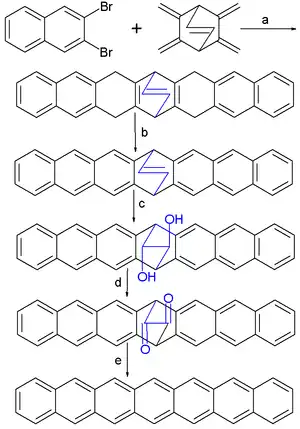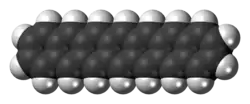Heptacene
Heptacene is an organic compound and a polycyclic aromatic hydrocarbon and the seventh member of the acene or polyacene family of linear fused benzene rings.[1] This compound has long been pursued by chemists[2][3][4] because of its potential interest in electronic applications and was first synthesized but not cleanly isolated in 2006.[5][6] Heptacene was finally fully characterized in bulk by researchers in Germany and the United States in 2017.[7]
 heptacene synthesis
heptacene synthesis
 | |
| Names | |
|---|---|
| Preferred IUPAC name
Heptacene | |
| Identifiers | |
3D model (JSmol) |
|
| ChemSpider | |
PubChem CID |
|
| UNII | |
CompTox Dashboard (EPA) |
|
| |
| |
| Properties | |
| C30H18 | |
| Molar mass | 378.474 g·mol−1 |
Except where otherwise noted, data are given for materials in their standard state (at 25 °C [77 °F], 100 kPa).
Infobox references | |
The final step is a photochemical decarbonylization with a 1,2-dione bridge extruded as carbon monoxide. In solution heptacene is not formed because it is very unstable being a reactive DA diene and quickly reacts with oxygen or forms dimers. When on the other hand the dione precursor is dissolved in a PMMA matrix first, heptacene can be studied by spectroscopy. Heptacene has been studied spectroscopically at cryogenic temperatures in a matrix.[8] When dissolved in sulfuric acid the heptacene dication is reported to be stable at room-temperature for more than a year in absence of oxygen.[9] "[Isolated] solid heptacene has a half-life time of several weeks at room temperature."[10]
Derivatives
 Figure 1.
Figure 1. Figure 2.
Figure 2.
7,16-Bis(tris(trimethylsilyl)silylethynyl)heptacene was synthesized in 2005.[11] This compound is stable in the solid state for a week but decomposes in contact with air. Its synthesis started from anthraquinone and naphthalene-2,3-dicarboxaldehyde. More stable substituted heptacenes have been reported: with stabilizing p-(t-butyl)thiophenyl substituents (Figure 1)[12] and with phenyl and triisopropylsilylethynyl groups (Figure 2).[13]
References
- Zade, Sanjio S.; Bendikov, Michael (2010). "Heptacene and Beyond: the Longest Characterized Acenes". Angewandte Chemie International Edition. 49 (24): 4012–5. doi:10.1002/anie.200906002. PMID 20468014.
- Clar, E. (1942). "Heptacen ein einfacher, "ultragrüner"︁ Kohlenwasserstoff (Aromatische Kohlenwasserstoffe, XXXV. Mitteil.)". Berichte der Deutschen Chemischen Gesellschaft (A and B Series). 75 (11): 1330–1338. doi:10.1002/cber.19420751114.
- Bailey, William J.; Liao, Chien-Wei (1955). "Cyclic Dienes. XI. New Syntheses of Hexacene and Heptacene1,2". Journal of the American Chemical Society. 77 (4): 992–993. doi:10.1021/ja01609a055.
- Boggiano, B.; Clar, E. (1957). "519. Four higher annellated pyrenes with acene character". Journal of the Chemical Society (Resumed): 2681. doi:10.1039/JR9570002681.
- Mondal, Rajib; Shah, Bipin K.; Neckers, Douglas C. (2006). "Photogeneration of Heptacene in a Polymer Matrix". Journal of the American Chemical Society. 128 (30): 9612–9613. doi:10.1021/ja063823i. PMID 16866498.
- a| Diels-Alder reaction of dibromonaphthalene forming a naphthyne and bicyclo[2,2,2]oct-2,3,5,6,7-pentaene with n-butyllithium in toluene 3 hours at -50 to -60 °C 53% chemical yield b| organic oxidation with P-chloranil in toluene 2 hours reflux and 81% yield c] Bishydroxylation with N-Methylmorpholine N-oxide and osmium tetroxide in acetone and t-butanol at room temperature for 48 hours, 83% yield d] Swern oxidation with trifluoroacetic acid in dimethyl sulfoxide and dichloromethane at -78 °C, 51% yield e] photochemical decarbonylization in a PMMA matrix at 395 nm
- Einholz, Ralf; Fang, Treliant; Berger, Robert; Grüninger, Peter; Früh, Andreas; Chassé, Thomas; Fink, Reinhold F.; Bettinger, Holger F. (2017). "Heptacene: Characterization in Solution, in the Solid State, and in Films". Journal of the American Chemical Society. 139 (12): 4435–4442. doi:10.1021/jacs.6b13212. PMID 28319405.
- Mondal, Rajib; TöNshoff, Christina; Khon, Dmitriy; Neckers, Douglas C.; Bettinger, Holger F. (2009). "Synthesis, Stability, and Photochemistry of Pentacene, Hexacene, and Heptacene: A Matrix Isolation Study". Journal of the American Chemical Society. 131 (40): 14281–14289. doi:10.1021/ja901841c. PMID 19757812.
- Einholz, R.; Bettinger, H. F. (2013). "Heptacene: Increased Persistence of a 4n+2 π-Electron Polycyclic Aromatic Hydrocarbon by Oxidation to the 4n π-Electron Dication". Angew. Chem. Int. Ed. 52: 9818–9820. doi:10.1002/anie.201209722. PMID 23873781.
- Einholz, Ralf; Fang, Treliant; Berger, Robert; Grüninger, Peter; Früh, Andreas; Chassé, Thomas; Fink, Reinhold F.; Bettinger, Holger F. (2017). "Heptacene: Characterization in Solution, in the Solid State, and in Films". Journal of the American Chemical Society. 139 (12): 4435–4442. doi:10.1021/jacs.6b13212. PMID 28319405.
- Payne, Marcia M.; Parkin, Sean R.; Anthony, John E. (2005). "Functionalized Higher Acenes: Hexacene and Heptacene". Journal of the American Chemical Society. 127 (22): 8028–9. doi:10.1021/ja051798v. PMID 15926823.
- Kaur, Irvinder; Stein, Nathan N.; Kopreski, Ryan P.; Miller, Glen P. (2009). "Exploiting Substituent Effects for the Synthesis of a Photooxidatively Resistant Heptacene Derivative". Journal of the American Chemical Society. 131 (10): 3424–5. doi:10.1021/ja808881x. PMID 19243093.
- Chun, Doris; Cheng, Yang; Wudl, Fred (2008). "The Most Stable and Fully Characterized Functionalized Heptacene". Angewandte Chemie International Edition. 47 (44): 8380–5. doi:10.1002/anie.200803345. PMID 18825763.